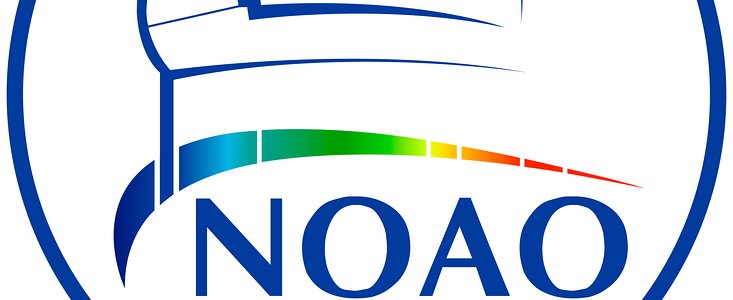Dissecting Light from Ancient Stellar Explosions
9 January 2006
In a feat resembling an intergalactic autopsy, astronomers have used the Gemini South telescope in Chile to obtain a detailed spectrum of an echo of light from an ancient supernova that enables them to identify the original star’s cause of death.
Beyond confirming that the team’s basic interpretation of the light echo was correct, the spectrum suggests strongly that the explosion was a Type-Ia supernova that originated with a compact white dwarf star in the Large Magellanic Cloud.
This result, announced today in Washington, DC, at the annual meeting of the American Astronomical Society, is an important step beyond the discovery of the ancient light echoes themselves, three of which were reported in the December 22, 2005, issue of Nature magazine. The supernova in the Large Magellenic Cloud that is suspected to be a Type-Ia occurred approximately 400 years ago. The survey team which authored this result has since found a fourth echo in the same nearby galaxy, located 160,000 light-years from Earth.
“These four echoes originated from supernovae that are unrecorded in human history,” said Nicholas Suntzeff, an astronomer from the National Optical Astronomy Observatory (NOAO) and co-author of the result. “Had an observer in the southern hemisphere looked up in the sky at the right time four centuries ago, such a supernova would have been as bright as the very brightest stars in the night sky, such as Sirius or Canopus, for many weeks.”
The spectrum of the echo arc shows that it was most likely a white dwarf star that exploded in a thermonuclear detonation that astronomers call a Type-Ia supernova. These supernovae are important sources of most of the iron and iron-like elements in the Universe. By counting the number of echoes with known ages, astronomers will be able to more precisely estimate the rate of buildup of these elements in galaxies over time.
“We took a spectrum of the brightest echo that we found, using the Gemini South telescope and the GMOS instrument with its slitlets aligned along the echo segments,” said co-author Armin Rest of NOAO. “We find that Type-II supernovae spectra do not fit the observation. The best comparative fit that we obtain is with SN 1991T, an overluminous Type-Ia supernova. The spectrum of a Type-Ibc, which is the type related to gamma-ray bursts, produces a noticeably worse fit, but cannot yet be ruled out.”
The light echoes were discovered by comparing images of the Large Magellanic Cloud (LMC) taken years apart. By precisely subtracting the common elements in each image, the team looks for evidence of invisible dark matter that might distort the light of stars in a transitory way, as part of a sky survey called SuperMACHO.
This careful image analysis also revealed a small number of concentric, circular-shaped arcs that are best explained as light moving outward over time, and being scattered and reflected toward Earth as it encounters dense pockets of cool interstellar dust.
The SuperMACHO team used the National Science Foundation’s Blanco 4-meter telescope and wide-area Mosaic imager at Cerro Tololo Inter-American Observatory near La Serena, Chile, to discover the echoes. Team members were able to precisely associate these echoes with the faint remnants of supernovae of unknown ages seen in radio telescope observations by noting that groups of echoes seemed to be moving away from three well defined positions in the galaxy.
These light echoes are the same type of phenomenon as common sound echoes, except it is light, not sound, that is being reflected. “Just as you can faintly hear an echo of yourself a little later in time when you shout 'Hello' toward a distant mountain cliff, these light echoes are the faint but precise imprints of the original light,” Suntzeff said. “The technique raises the prospect of identifying the source of many popular supernovae that have occurred as long as 2,000 years ago.”
The bright supernovae recorded in northern skies over the past 1,000 years of probable Type-Ia origin, such as SN 1604 studied by Kepler, SN 1592 studied by Tycho Brahe, and SN 1006 studied by Chinese astronomers, will be perhaps the easiest targets. Echoes from the famous Crab Nebula supernova of 1054 may also be visible.
This discovery confirms a prediction by visionary astronomer Fritz Zwicky, who suggested in 1940 that the light from historical supernovae could still be seen as faint echoes.
More information
Co-authors of this result from poster paper 132.14 at the AAS meeting include C. Smith, K. Olsen, A. Zenteno, C. Aguilera and T. Matheson (NOAO); C. Stubbs, A. Garg, P. Challis (Harvard University); M. Bergmann (Gemini Observatory); A. C. Becker, A. Miceli, R. Covarrubias (University of Washington); G. A. Miknaitis (Fermilab); D. L. Welch (McMaster University, Ontario); J. L. Prieto (Ohio State University); M. Huber, S. Nikolaev, K. Cook (Lawrence Livermore National Laboratory); and, D. Minniti, A. Clocchiatti, L. Morelli (Pontifica Universidad Católica de Chile).
The National Optical Astronomy Observatory is operated by the Association of Universities for Research in Astronomy Inc. (AURA), under a cooperative agreement with the National Science Foundation.
Links
- Color graphics that illustrate the process and appearance of a supernova light echo are available from NOAO Press Release 05-12
Contacts
Douglas Isbell
Office of Public Affairs and Educational OutreachNational Optical Astronomy Observatory
Tel: 520/318-8230
Email: disbell@noao.edu
About the Release
| Release No.: | noao0602 |
| Legacy ID: | NOAO 06-02 |
| Facility: | Víctor M. Blanco 4-meter Telescope |
| Instruments: | Mosaic I |
| Science data: | 2005Natur.438.1132R |



